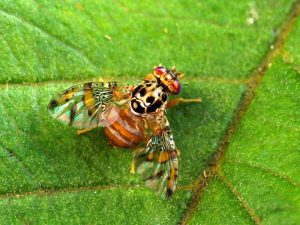
The Mediterranean fruit fly, one of many invasive species that threaten California’s environment and food production.
California Invasive Species Action Week is underway this week and is continuing until Sunday, June 10. CDFA works in partnership with other state and federal agencies to try to prevent invasive species from entering California, and then managing infestations as effectively as possible, with a goal of eradication in most cases.
In focusing on these activities this week, the objectives are to increase public awareness of invasive species and promote public participation in the fight against them.
CDFA works in this area on a number of fronts. In its Plant Health and Pest Prevention Services Division, operations are ongoing for invasive species like the Asian citrus psyllid and the fatal disease of citrus it spreads, huanglongbing, or citrus greening. Other ongoing projects include management of another insect with the potential to spread plant disease, the glassy-winged sharpshooter. Additionally, the division regularly eradicates infestations of invasive fruit flies like the Mediterranean fruit fly (Medfly) and the Oriental fruit fly. The division’s Report A Pest app encourages Californians to take photos of suspected invasive species and send them in for identification and action, if necessary.
California’s Border Inspection Stations, which are managed by CDFA, are on the lookout year-round for boats that may be transporting invasive aquatic mussels like Quagga and Zebra mussels.
Veterinarians and staff in CDFA’s Division of Animal Health and Food Safety Services are currently working to eradicate an invasive species outbreak–virulent Newcastle disease–in Southern California. This disease threatens birds throughout California and is often fatal to chickens.
CDFA serves as co-chair of the Invasive Species Council of California, partnering with the California Resources Agency, the California State Transportation Agency, the California Health and Human Services Agency and the Office of Emergency Services to work with the appointed members of the California Invasive Species Advisory Committee to develop and manage a statewide invasive species action plan.
Invasive species pose a constant threat to California’s uniquely diverse environment and its agricultural production, and they’re also quite costly. Researchers at Cornell University estimate that invasive species cause $120 billion in damage in the US each year.
Click here for more information about California Invasive Species Action Week.


